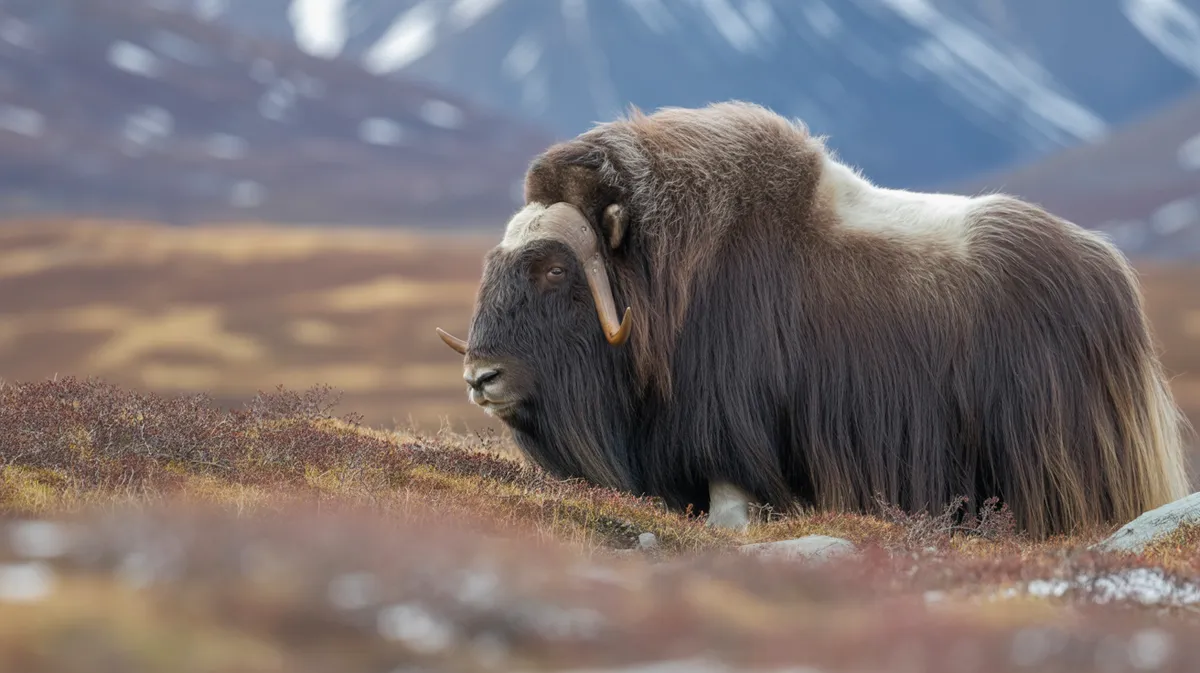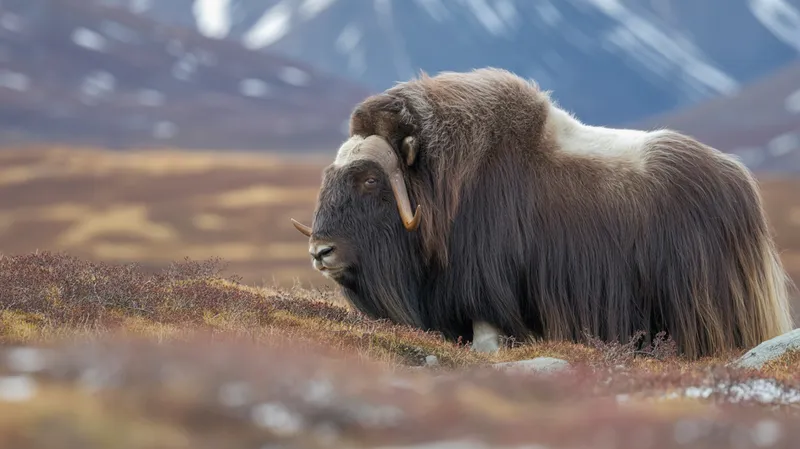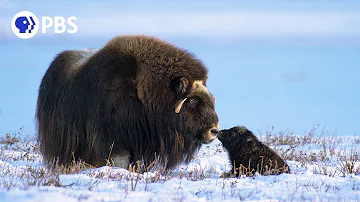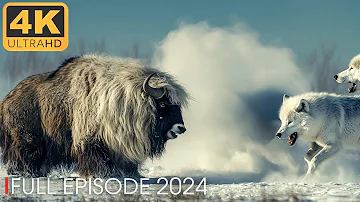
Musk Ox
Ovibos moschatus

Meet the Musk Ox
The musk ox is a large, shaggy-coated mammal native to the Arctic tundra of North America and Greenland. Renowned for its thick, insulating fur and strong odor emitted by males during the rut, the musk ox is well-adapted to survive in harsh, cold climates. Both males and females have curved horns, and they form tight defensive circles to protect against predators like wolves. Social and resilient, musk oxen graze on grasses, mosses, and lichens, playing a key role in the Arctic ecosystem.
Classification
Mammal
Habitat
Arctic tundra
Diet
Herbivore
Lifespan
12-20 years
Conservation
Least Concern
Weight
180-410 kg
📖Fascinating Facts
Ancient Survivors
Musk oxen have roamed the Arctic for thousands of years, surviving the last Ice Age alongside mammoths and saber-toothed cats.
Incredible Insulation
Their underfur, known as qiviut, provides superior insulation, allowing musk oxen to thrive in temperatures as low as -40°C.
Musky Scent
Males emit a strong musky odor from glands near their eyes during the breeding season to attract females and signal dominance.
📋Detailed Description
The musk ox (Ovibos moschatus) is a robust, stocky ungulate characterized by its dense, double-layered coat, which consists of a long, coarse outer layer (guard hairs) and a soft, insulating underwool called qiviut—one of the finest natural fibers known. Adults typically stand 1.1–1.5 meters at the shoulder and weigh between 180 and 410 kilograms, with males being larger than females. Both sexes possess prominent, downward-curving horns with broad bases that nearly meet at the center of the forehead, forming a protective boss. Musk oxen are highly social, living in herds that can range from small family groups to aggregations of 10–40 individuals, especially outside the rutting season. Their social structure is matriarchal, with older females often leading group movements and decisions. During the harsh Arctic winter, musk oxen use their strong hooves to break through snow and ice to access vegetation, relying on their exceptional memory to locate buried food sources. Their primary diet consists of sedges, grasses, willows, mosses, and lichens. When threatened by predators such as wolves, musk oxen form a defensive circle or line, presenting their horns outward and sheltering calves in the center—a behavior that exemplifies their cooperative defense strategy. Adapted to extreme cold, musk oxen have a low metabolic rate and specialized nasal passages that warm incoming air, minimizing heat loss.
💡 Did you know?
The qiviut wool shed by musk oxen in spring is eight times warmer than sheep’s wool and is highly prized for making luxury garments.
🔬Research & Sources
Wikipedia Summary
The muskox is a hoofed mammal of the family Bovidae. Native to the Arctic, it is noted for its thick coat and for the strong odor emitted by males during the seasonal rut, from which its name derives. This musky odor has the effect of attracting females during mating season. Its Inuktitut name "umingmak" translates to "the bearded one".
Last Modified: 6/3/2025
🎭Behavior & Social Structure
Musk oxen are primarily diurnal, with peak activity occurring during the morning and late afternoon. They spend much of their day grazing and ruminating, often moving slowly across the tundra in search of food. Social interactions are complex; individuals communicate through vocalizations, body postures, and scent marking. During the rut (late July to early September), males engage in dramatic dominance displays, including head-butting contests that can be heard from over a kilometer away. Outside the breeding season, aggression is rare, and herds exhibit strong cohesion. Musk oxen are highly vigilant, with sentinels often posted on the periphery of the group. In winter, they conserve energy by reducing movement and seeking sheltered microhabitats, sometimes using wind-carved snowdrifts for protection. Feeding involves digging through snow with their hooves and muzzles, and they are capable of surviving on extremely sparse forage due to their efficient digestive systems.
👶Reproduction & Life Cycle
Musk oxen are polygynous, with dominant males controlling access to receptive females during the rut. Courtship involves males emitting a strong musky odor from preputial glands and performing displays such as circling, pawing, and urinating. After mating, gestation lasts approximately 8–9 months (235–245 days), with most calves born in late April to early June, coinciding with the brief Arctic summer. Females typically give birth to a single calf, which is precocial and able to stand and follow the herd within hours. Calves are nursed for 10–14 months but begin grazing within a few weeks. Maternal care is intense, with mothers and other herd members providing protection from predators. Sexual maturity is reached at 2–4 years, though males may not successfully breed until they are older and able to compete for dominance.
🛡️Adaptations & Survival
Musk oxen exhibit a suite of adaptations for Arctic survival. Their qiviut underwool provides exceptional insulation, allowing them to withstand temperatures as low as -40°C. The long guard hairs shed snow and repel moisture, preventing heat loss. Their compact body shape minimizes surface area relative to volume, reducing heat dissipation. Specialized nasal turbinates warm and humidify inhaled air, conserving body heat and water. Hooves are broad and sharp-edged, enabling efficient digging through snow and traversing icy terrain. Behaviorally, their defensive formations deter predators, and their seasonal movement patterns optimize access to forage. Their digestive system is adapted for extracting maximum nutrients from fibrous, low-quality vegetation, with a large rumen and slow passage rate.
🎨Cultural Significance
Musk oxen hold deep significance for Arctic Indigenous peoples, such as the Inuit and Inuvialuit, who refer to them as 'umingmak' ('the bearded one'). Traditionally, musk oxen provided meat, hides, and qiviut for clothing and tools. Qiviut is still highly valued for its warmth and softness, supporting local economies through sustainable harvesting. Musk oxen feature in Arctic folklore and are symbols of resilience and adaptation. Their dramatic defensive behavior and unique appearance have made them icons of the tundra in art, literature, and ecotourism.
🔬Recent Research & Discoveries
Recent research has focused on the impacts of climate change on musk ox foraging ecology, reproductive success, and disease susceptibility. Studies using GPS collars and remote sensing have revealed detailed movement patterns and habitat preferences, highlighting the importance of snow conditions and forage availability. Genetic analyses have clarified the species’ phylogeography, indicating post-glacial recolonization routes and low genetic diversity in some reintroduced populations. Investigations into qiviut properties have advanced understanding of its thermal insulation and potential biomedical applications. Long-term monitoring projects in Greenland, Canada, and Norway continue to assess population health and inform conservation strategies.
🎥Wildlife Videos

Musk Oxen Vs Arctic Wolves | Animal Super Parents | BBC Earth
In the Arctic tundra, a herd of musk ox are up against a pack of hungry wolves. Will the parents successfully protect their calves ...
BBC Earth

The Last Giants of Scandinavia | FULL DOCUMENTARY | Europe's Wilderness | @UltimateNatureDocs
This episode is about on the most ancient and majestic animal of the continent: the musk ox seems like the last survivor of the ice ...
Ultimate Nature Documentaries

Newborn Muskox's First Day
Within hours of being born, this calf is ready to explore. Please LIKE and SUBSCRIBE if you enjoyed it! **More info & videos ...
Nature on PBS

ARCTIC PREDATOR | The Unsung Heroes of the Arctic | Nature Animal Documentary
ARCTIC PREDATOR | The Unsung Heroes of the Arctic | Nature Animal Documentary The Arctic! The second most unforgiving ...
Nature's Moments

Muskox: The Kings of the Arctic Plains
As the wind howls across the Arctic tundra, a mighty creature roams free. It stands tall, with a thick coat of fur and sharp, curved ...
KiloFact - Interesting Facts

Profiles of Nature: The Muskox (full documentary)
Early 90's Discovery Channel VHS rip.
Forgotten Documentaries
🌍Habitat Information
The Musk Ox typically inhabits Arctic tundra environments. Musk Oxs have adapted to their environments with specialized features and behaviors.
Primary Habitat:
Arctic tundra
More detailed habitat information will be available soon.
🛡️Conservation Status
The Musk Ox is currently classified as Least Concern. Conservation efforts are crucial for preserving this species for future generations.
Common Threats:
- 🏠Habitat loss and fragmentation
- 🌡️Climate change impacts
- 🎯Hunting and poaching
- 🏭Human-wildlife conflict
⚠️Threats & Conservation Challenges
Historically, musk oxen faced severe declines due to overhunting and habitat disturbance, leading to extirpation from parts of their range by the early 20th century. Today, populations are stable or increasing in many areas due to successful reintroduction and protection efforts, but localized threats persist. Climate change poses significant risks, including increased frequency of rain-on-snow events that create ice layers, restricting access to forage and causing starvation. Disease outbreaks, such as those caused by lungworms and bacterial infections, can also impact populations, especially in small, isolated herds. Human activities, including oil and gas development, can fragment habitat and increase stress. Predation by wolves remains a natural threat, particularly to calves. Overall, the species is listed as Least Concern, but ongoing monitoring is essential.
🔬Scientific Classification
Scientific Name
Ovibos moschatus
Classification Hierarchy
🔍 About Taxonomic Classification
Taxonomic classification is a hierarchical system used by scientists to classify and organize living organisms based on shared characteristics and evolutionary relationships.
The system moves from broad categories (Kingdom) to increasingly specific ones, with each animal's scientific name typically consisting of its Genus and species.
📝Community Notes
Share your observations and insights about the Musk Ox with our community of wildlife enthusiasts.
Join Our Community
Sign in to share your observations and connect with fellow wildlife enthusiasts.
Sign In to ContributeNo community notes yet
Be the first to share your observations about the Musk Ox!
Explore Musk Ox
Select a tab above to learn more about this amazing animal.
📸Photo Gallery
No photos available for this animal yet.
🌟Discover More Wildlife
Continue your journey of discovery with more fascinating animals from our database
